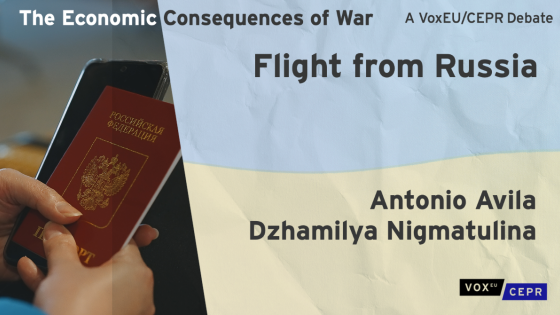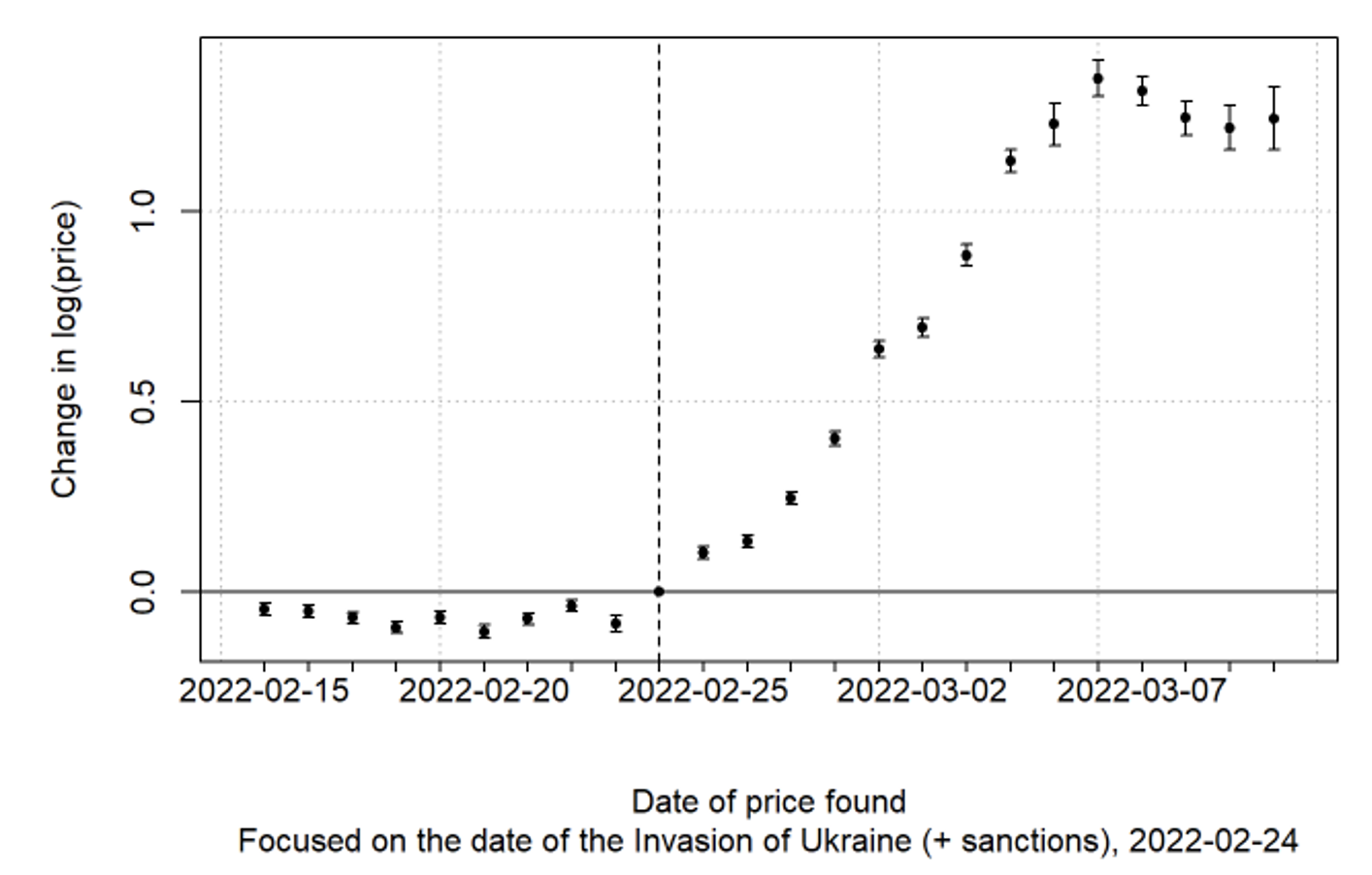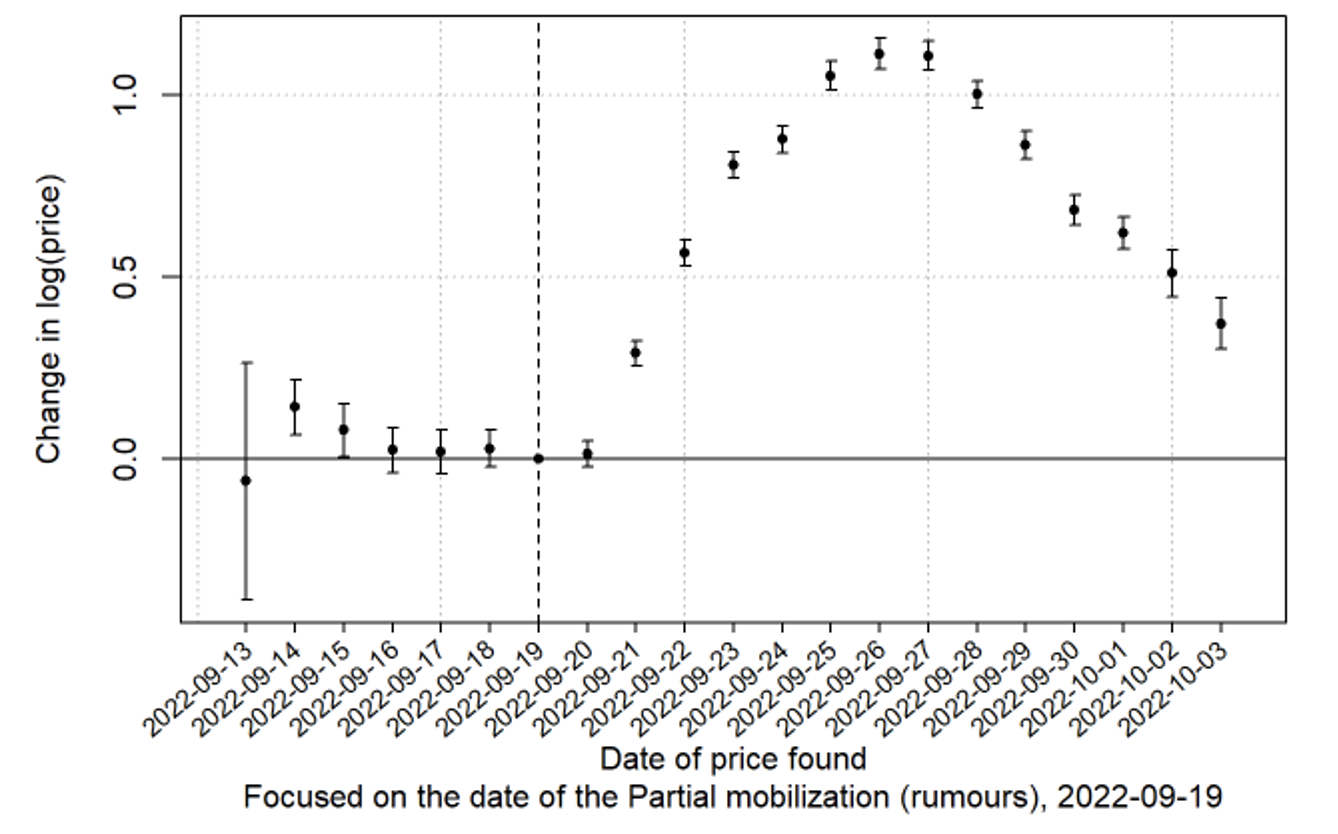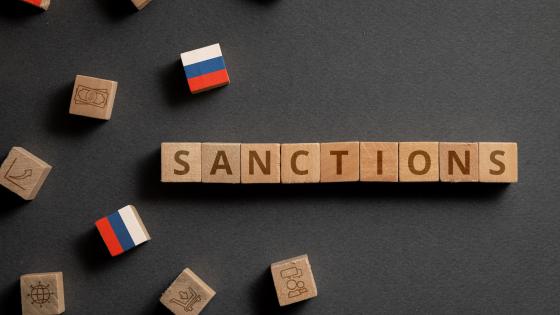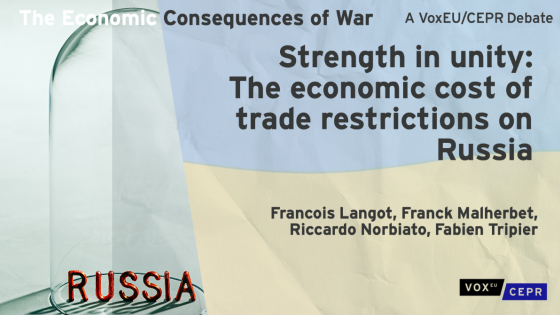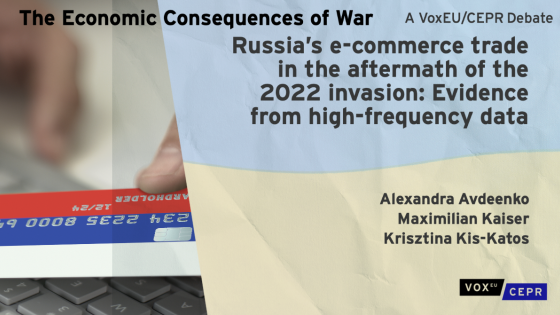On 24 February 2022 the Russian Army began a full-scale invasion of Ukraine. First and foremost, if brought an unthinkable human tragedy in Ukraine. The invasion also unleashed a series of economic, social, and political events in Russia itself (Simola 2022, Kaiser et al. 2022). It affected thousands of people’s lives and expectations for the future. We collected outgoing flight prices before and after the 24 February to learn how Russians felt about staying in Russia.
How much did the Russian people want to flee at any point in time? When was the biggest exodus? How much are Russian men willing to pay to save their lives? Flight prices can tell a story about those in Russia reacting to the war.
In looking at flights, we recall that many sanctions affected the airline industry, leaving direct flights only to Asian, African, and Latin American destinations. We will separate permanent flight price moves from temporary ones to isolate demand and supply factors.
Figure 1 illustrates the comparison of flight prices
within Russia versus those departing from Russia to another country before and after the invasion, up until the present day. The purple line represents the average price of flights departing from Russia for a flight booked one day in advance. For instance, on 23 February, the average price for flights booked for departure on 24 February was roughly 40,000 roubles.
Figure 1 Average price of return flights that go out of Russia (or not) by date in the market and time to departure
The blue line on the graph represents the average price for flights departing more than one day in the future, but within one week. On 24 February, the average price for such flights within a week was in the range of 30,000-40,000 roubles. The green line represents the average price for flights departing later than one week but within a month, while the yellow line tracks the average price for flights departing over a month into the future.
The figure shows large spikes in flight prices at the end of February and beginning of September.
The start of the war and the criminal prosecution for the use of word “war” caused flight prices to increase significantly. Within a week after the invasion, many people in Russia decided to leave. Independent media channels were shut down within five days, and the word “war” itself became illegal on 5 March. Journalists, dissidents, and protesters fled fearing prosecution. People with good opportunities abroad – IT workers, scientists, and businessmen – also saw the invasion and prosecution as a reason to relocate, along with foreigners whose companies halted Russian operations. At its highest, the average prices were eight times the pre-war level, later falling to about three times the pre-war average price as we see in the figure.
Rumours circulated in mid-April that on 9 May, Russia's Victory Day commemorating the end of WWII, President Putin would announce a mass mobilisation or annex territories in Ukraine.
These rumours caused a spike in flight prices, with costs rising to 100,000 roubles (over four times the pre-war price), as some people were prompted to leave. However, the announcement did not take place on 9 May, and the market for flights calmed down straight after. Instead, mobilisation was announced on 21 September and several Ukrainian regions were annexed on 30 September, resulting in the biggest price increase, with flight prices shooting up to 300,000 roubles which is 12 times the pre-war prices.
Are the price spikes telling us exactly how much Russians are willing to pay to leave Russia? Not quite, as these could be driven by both demand and supply reasons. Understanding the underlying causes can help to provide insight into the trends observed in the data.
On the demand side, some people may have purchased tickets out of fear of prosecution or mobilisation, leading to an increase in demand and prices for flights. On the supply side, the withdrawal of planes from the market, particularly by European and North American airlines, has caused a decrease in flight availability and therefore an increase in prices for remaining flights. The airline withdrawal is permanent, so it will continue to affect flight prices in the near future and long term.
Therefore, all changes in demand and supply are reflected in the purple and blue price lines, while the green and yellow price lines price in the permanent shifts in supply. We take the difference between the immediate departure prices (purple and blue) and the later departure prices (green and yellow) to evaluate the change in demand alone, on a particular day. During the first ten days of the war, prices increased from 40,000 to 200,000 roubles. The rise from 80,000 to 120,000 roubles was due to a supply shock, while the remaining 80,000 increase was due to a demand shock.
The spike during mobilisation is fully driven by Russians wanting to leave, because there were no further withdrawals of airlines form Russia in September 2022. Therefore, we can be confident that more people left Russia at the end of September than at the end of February – and increase in prices due to demand to flee was 200,000 roubles after mobilisation versus 80,000 roubles at the start of the war.
Another way to get at the increase in flight prices due to demand is to compare prices for the same airlines and destinations. This helps us see the increase more clearly abstracting from airlines withdrawing from Russia. The flight price rose 140% in the first days of the invasion, and about a 110% after mobilisation for the same flight (as opposed to three-fold increases both at the start of the war and during mobilisation calculated with our previous method). However, this is likely a lower bound for the demand for fleeing Russia: flight prices for the exact flights have been capped due to flights reaching maximum capacity.
Figure 2 Effect on average ticket price departing in next 15 days around 24 February 2022
Figure 3 Effect on average ticket price departing in the next 15 days around 19 September 2022
What can an estimated increase of demand for flights teach us about Russians? This is a textbook case to calculate how much Russians value their lives. According to the assumptions in Mironov and Itshoki (2022), when Russian President Putin announced mobilisation, the probability of dying within six months increased from nearly 0% to 2% (0.15 x 0.14)
for men ages 20-34.
Let’s assume that the people buying tickets are only men in risk of mobilisation, as other family members could safely leave Russia at a later date. By analysing the increase in ticket prices after 21 September, we can determine how much these men are willing to pay to decrease the threat of death. Using this information, we can calculate the value of a person's life, which is equal to the additional amount they are willing to pay (200,000 roubles more) divided by the increased probability of dying (2% higher). In this case, the value of life comes out as ten million roubles ($370,000 at purchasing power parity), which is comparable to the value of 5.3 million roubles cited in a 2019 Sberbank study using insurance data and the range of 5-7.4 million roubles that the government has chosen as compensation for the families of those who have died in the war.
Conversely, you could calculate how people perceive their probability of death given the price they are ready to pay for the flight from Russia during mobilisation. If we take the value of life of 5.3 million from the Sberbank study, people paying an additional 200,000 roubles for flights after the announcement of mobilisation expect their increased probability of death to be 3.8% higher.
It's important to note that the increase in ticket prices reflects the cost of life for wealthier individuals who can afford the tickets and value their own lives highly. Many people of lower income, and those in areas outside of Moscow and St. Petersburg may have left by car and paid a lower monetary cost but may have faced a higher physical cost due to queues at the border. On the other hand, it's worth considering that the cost of moving is not limited to just the price of a flight ticket, especially for those wealthier residents of Moscow.
In 2020, Sergei Guriev compared the number of lives saved versus the GDP lost in Russia during the Covid-19 lockdowns.
He found that the Russian government was not making a good trade-off by allowing too many valuable lives to be lost in exchange for too little GDP gained. Today, the situation is different. Sending Russians to fight and kill Ukrainians is catastrophic not only for the lives lost, but also for the Russian GDP, since the valuable working-age labour is leaving the economy. What is on the other side of the scale today?
The further waves of mobilisation are likely in January and February 2023. The flight prices may give more hints of how much Russians value their lives and how it changes as the war goes on.
Note: The project that produced these results had the support of a scholarship from Fundació Bancària ”la Caixa” (ID 100010434), with code LCF/BQ/EU22/11930044
References
Kaiser, K Kis-Katos and A Avdeenko (2022), "Russia’s e-commerce trade in the aftermath of the 2022 invasion: Evidence from high-frequency data", VoxEU.org, 19 May.
Mironov, M and O Itshoki (2022), “Призванная республика”, Novaya Gazeta Europe, 26 September.
Simola, H (2022), "War and sanctions: Effects on the Russian economy", VoxEU.org, 15 December.
